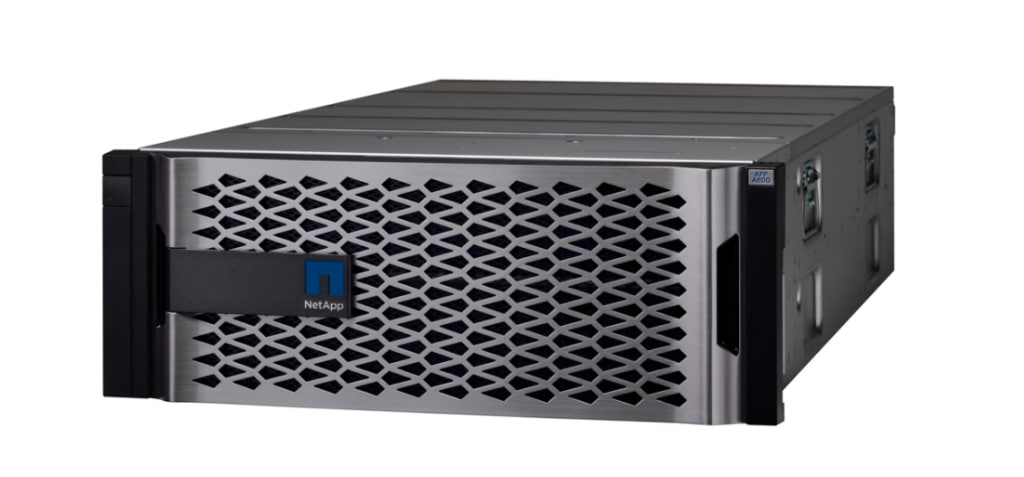Looking For a Modern SAN Solution? Think NetApp Flash!


John Woodall
 NetApp AFF A800[/caption]
Over the past few years, NetApp has transformed into a new company, innovating as never before with SAN as a major focus. It is no longer accurate to say that NetApp is a NAS company and not a “real SAN” company. The benefits of flash-based NetApp SAN stand alone in the industry today. If you’re looking for the best in modern SAN storage, NetApp flash should be at the top of your list.
NetApp AFF A800[/caption]
Over the past few years, NetApp has transformed into a new company, innovating as never before with SAN as a major focus. It is no longer accurate to say that NetApp is a NAS company and not a “real SAN” company. The benefits of flash-based NetApp SAN stand alone in the industry today. If you’re looking for the best in modern SAN storage, NetApp flash should be at the top of your list.
So what makes NetApp SAN different? It’s all about modernization.
For starters, let’s look at some of the “table stakes” for all-flash arrays:
- Outstanding performance ranging from hundreds of thousands to millions of IOPS at <1µs of latency and multiple GBps of system throughput, which means users spend less time on performance management
- Multiple data efficiency technologies such as compression, dedupe, and in the case of NetApp, compaction, to reduce cost
- Significant reduction of data center power, space, and cooling costs due to the lower relative power draw of an all-flash array
- NetApp is leading in flash and SAN. According to IDC, NetApp all-flash arrays are number one. Of the top 5 SAN vendors being tracked, NetApp is the fastest growing SAN vendor.
- NetApp offers storage efficiency and performance guarantees. This combination is unique and gives NetApp AFF customers the ability to deploy their most mission-critical applications with confidence.
- NetApp is the only vendor shipping an end-to-end NVMe array. NetApp has shipped multiple PBs of NVMe-based storage, and with the introduction of the AFF A800, NetApp is shipping the first end-to-end NVMe array for the most demanding applications where speed is the new scale.
- NetApp AFF supports NVMe-oF for Fibre Channel. This is a significant benefit to customers with existing NetApp AFF A300, A700, A700/s, and A800 systems. By ensuring the right version of ONTAP and compatible HBAs, a customer can change from running FCP to NVMe-oF, no other changes needed. This simple upgrade can yield up to 60% more IOPS and reduce latency by up to half. This is the epitome of investment protection and demonstration of NetApp’s commitment to future proofing.
- NetApp is the only large-scale storage vendor providing a host-based NVMe solution with shared storage for persistence and data protection. MAX Data host-based software allows systems to recognize and take advantage of host-based storage class memory (SCM) products such as NVDIMM or 3D Xpoint/Optane for extreme performance. If you are running NetApp AFF with hosts running MAX Data, you can integrate NetApp’s proven and highly efficient Snapshot technology to back up host-based data to persistent storage on AFF.
- NetApp is the only storage vendor providing realistic, full-featured cloud integration. In the era of modernization, it is impossible to ignore the inevitable adoption of cloud services. With NetApp all-flash SAN storage, you can take advantage of the NetApp Data Fabric, giving you the ability to replicate data from flash to HDD, bidirectionally between ONTAP and Element OS, or to ONTAP in the cloud (Cloud Volumes ONTAP). This is a truly unique value proposition. From data protection workflows, dev/ops, test/dev, and more, the ability to connect easily to cloud-based services is quickly becoming a requirement for many enterprises. The unmatched flexibility, agility, and composability of the NetApp Data Fabric means your NetApp SAN can do things no other SAN offering can do. Your creativity is the only limit.
- NetApp allows further cost reduction via FabricPools. This data tiering feature in ONTAP allows your performant data to reside on an all-flash tier and your “cold” data to seamlessly move to a lower cost S3 target. This can be tiered on-premises and/or to an S3 target on your cloud provider of choice.
- NetApp has a scale-out architecture that is powered by intelligence and characterized by simplicity. Scale-out is not uncommon for NAS offerings, and NetApp has clearly dominated that space. That same scale-out capability is a feature of ONTAP regardless of protocol. No more forklift upgrades, just scale your SAN nondisruptively with more flash or disks. You can even mix and match models. With application profiles, automated data placement, and FlexGroups, it is far easier to quickly set up your SAN according to best practices and let the system balance out data placement with nondisruptive data migration based on the cluster’s usage characteristics, resource availability, and more.
- NetApp offers true adaptive Quality of Service (QoS). It’s not just some “fair share scheme.” NetApp provides true adaptive QoS that allows the system to guarantee the performance needed for your key data sets and keeps others in their respective swim lanes. If you need to change the performance for a given volume, just dynamically change the parameters and keep serving data.
John Woodall
John is Vice President of Engineering at General Datatech, LLC (GDT) and is located in Palo Alto, California. John has more than 30 years of experience in technology and a background focused on enterprise and infrastructure architecture, large scale systems engineering, strategic planning and technology management. In these roles, John designed and implemented and led teams delivering complex systems in demanding, mission-critical, large-scale, enterprise and cloud environments. At GDT, John focuses on strategic direction, evaluating emerging technologies, trends, and practices in order to enable customers to accelerate their transformations and the modernization of their technical and operational models. Prior to joining GDT, John held executive, architecture and management roles at Integrated Archive Systems, Symantec, Solectron (now part of Flex), Madge Networks and Elsevier MDL.